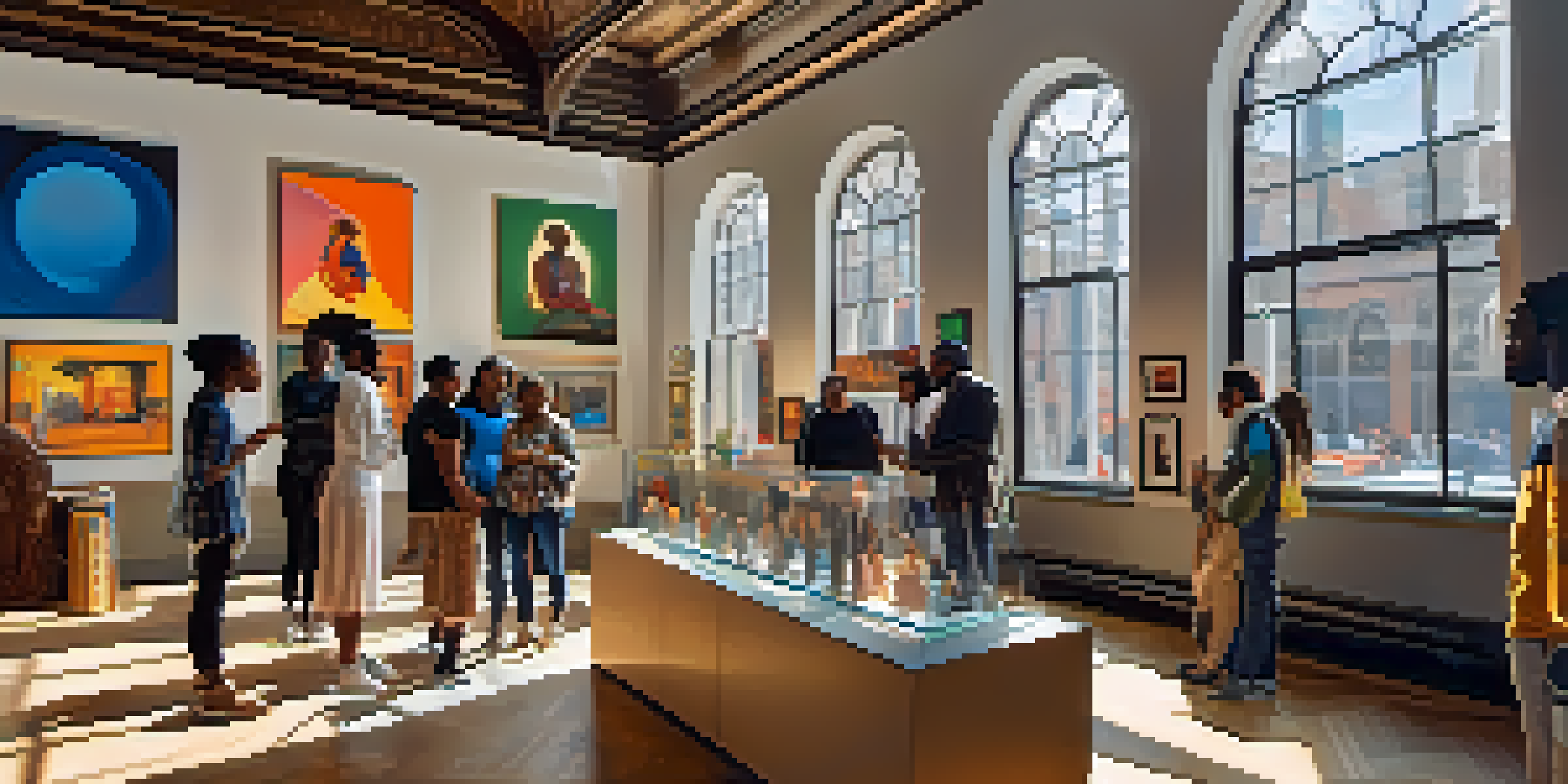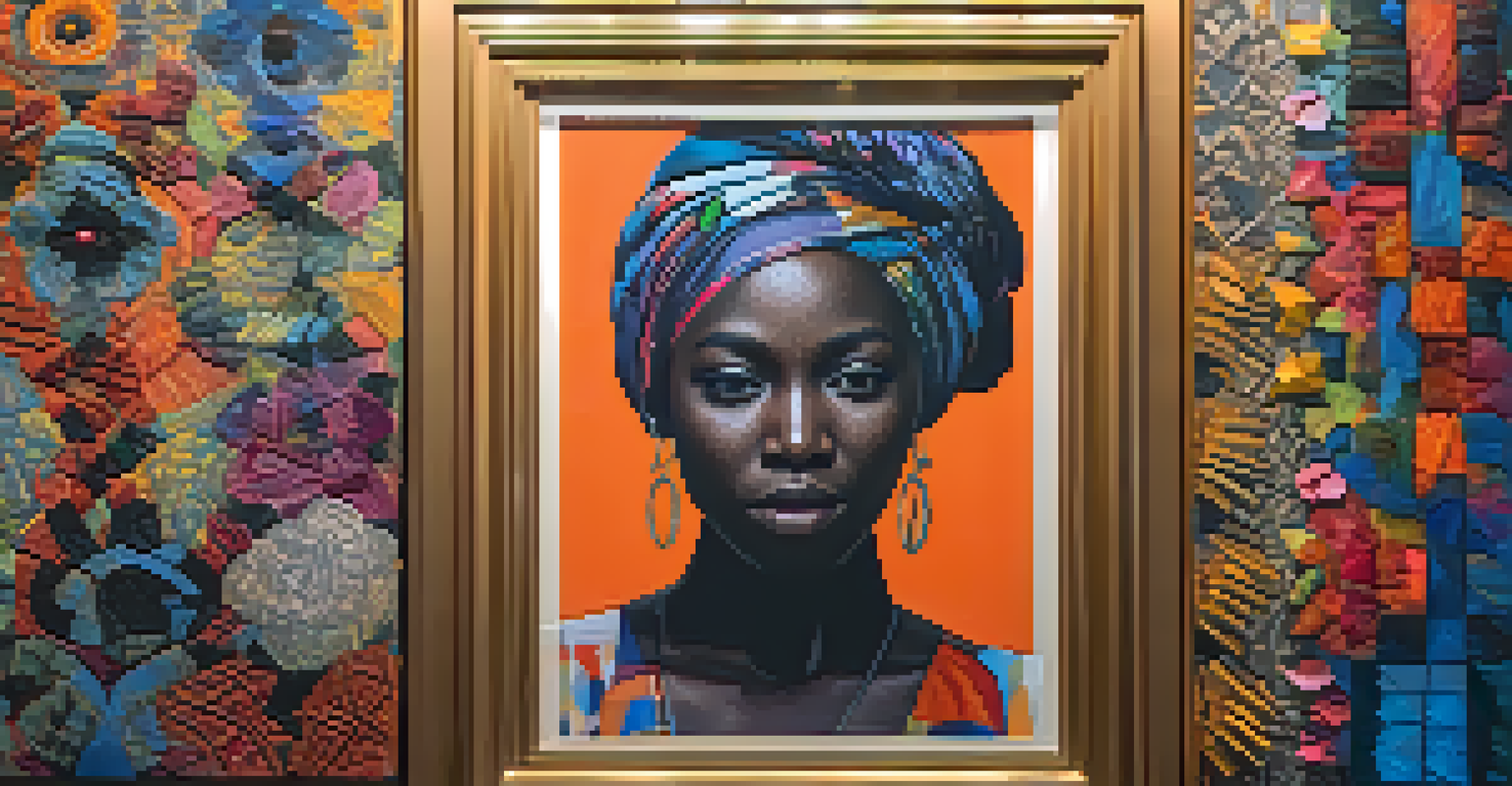Highlighting Black-Owned Art Galleries in New York City

Understanding the Importance of Black-Owned Art Galleries
Black-owned art galleries play a crucial role in showcasing diverse perspectives in the art world. They provide a platform for underrepresented artists to share their stories and experiences through their work. This emphasis on cultural representation not only enriches the art scene but also fosters a deeper understanding of Black history and identity.
Art is a way of survival.
By supporting these galleries, we contribute to a broader dialogue about race, culture, and community. They often highlight local artists, creating a nurturing environment for talent to thrive and evolve. This dynamic fosters a sense of belonging and pride within the community, making the galleries more than just exhibition spaces.
Moreover, these galleries serve as educational resources, hosting workshops, talks, and events that engage the public. They help demystify the art-buying process and encourage conversations about art appreciation. Ultimately, they invite everyone to participate in the broader narrative of art and culture.
Exploring the Artistic Landscape of NYC
New York City is a melting pot of cultures, and its art scene reflects this diversity. From Harlem to Brooklyn, each neighborhood contributes its unique flavor to the artistic landscape. Black-owned galleries are integral to this vibrant tapestry, offering a distinct voice that resonates throughout the city.

As you stroll through the streets, you'll find galleries that not only showcase visual art but also celebrate music, literature, and performance. These spaces often act as community hubs, where creativity flourishes and connections are made. The eclectic mix of styles and mediums showcases the rich cultural heritage present in the city.
Importance of Black-Owned Galleries
Black-owned art galleries are vital for showcasing diverse perspectives and fostering community engagement in the art world.
The energy of NYC art brings people together, sparking curiosity and inspiration. Visiting these galleries allows you to engage with the local community and experience the stories behind the art. It's an invitation to explore, learn, and appreciate the talents of Black artists in a city that thrives on creativity.
Spotlight on Notable Black-Owned Art Galleries
Among the notable Black-owned art galleries in NYC is the Studio Museum in Harlem, renowned for its dedication to contemporary Black art. Founded in 1968, it has become a vital space for artists of African descent to exhibit their work and connect with the community. The museum's innovative programs and exhibitions continue to inspire new generations of artists and art lovers alike.
The role of art is to make a difference, to change the world for the better.
Another gem is the KAVI GALLERY, which focuses on contemporary art from Africa and the African diaspora. With a commitment to promoting cultural dialogue, KAVI GALLERY showcases works that challenge perceptions and tell powerful stories. Their exhibitions often feature emerging artists, making it a dynamic space for fresh perspectives.
Additionally, the Aljira, a Center for Contemporary Art, provides a platform for innovative art and artists. With a focus on fostering new talent, Aljira hosts exhibitions, workshops, and community events that promote artistic expression. This gallery exemplifies how Black-owned spaces can drive creativity and cultural engagement.
Promoting Community Engagement Through Art
Black-owned art galleries often prioritize community engagement, creating spaces where dialogue and creativity intersect. Many galleries host events that invite the public to participate in discussions about art, culture, and social issues. This approach fosters a sense of community ownership and connection to the art being showcased.
Workshops and art classes are frequently offered, providing opportunities for individuals to express themselves creatively. These programs can empower local residents, offering them tools to explore their artistic potential. In this way, galleries become more than just places to view art; they transform into nurturing environments for budding artists.
Community Engagement Through Art
These galleries create nurturing environments that empower local residents and encourage participation in cultural dialogues.
By engaging the community, these galleries help cultivate an appreciation for art that goes beyond aesthetics. They promote understanding and empathy, allowing individuals to connect with the narratives behind the works. This emphasis on community engagement is a hallmark of Black-owned art galleries, making them invaluable assets to NYC.
Challenges Facing Black-Owned Art Galleries
Despite their importance, Black-owned art galleries face numerous challenges in the competitive NYC art scene. Limited funding and resources can hinder their ability to sustain operations and curate ambitious exhibitions. This financial strain often means that galleries must be innovative and resourceful to survive.
Additionally, systemic barriers within the art world can make it difficult for Black artists and gallery owners to gain recognition. Many galleries struggle to secure partnerships with larger institutions or funding organizations, limiting their growth potential. This lack of visibility can perpetuate the cycle of underrepresentation in the broader art market.
However, many Black-owned galleries are rising to the challenge, employing creative strategies to connect with audiences and secure support. By building strong community ties and embracing digital platforms, they are redefining their role in the art ecosystem. This resilience is a testament to the passion and dedication of those who run these extraordinary spaces.
The Future of Black-Owned Art Galleries in NYC
The future of Black-owned art galleries in NYC looks promising, with a growing recognition of their importance in the art world. As more people seek to support diversity and inclusion, these galleries are poised to become key players in shaping the future of contemporary art. This shift in focus bodes well for the representation of Black artists and their narratives.
Moreover, the increasing interest in art collecting and investment offers new opportunities for these galleries to thrive. As collectors become more aware of the significance of supporting diverse voices, there is a potential for increased patronage. This could lead to more exhibitions, events, and resources that empower the galleries and their artists.
Challenges and Future Outlook
Despite facing funding and recognition challenges, Black-owned galleries are evolving and gaining support as the art world values diversity.
Ultimately, the resilience and creativity of Black-owned galleries will continue to drive their evolution. By embracing innovation and fostering community relationships, they can adapt to the changing art landscape. The future is bright for these vital cultural spaces, and they will surely continue to inspire and challenge us all.
How to Support Black-Owned Art Galleries
Supporting Black-owned art galleries is an essential way to promote diversity in the art world. You can start by visiting these galleries, attending exhibitions, and participating in events. Engaging with the art and artists helps foster a sense of community and encourages galleries to continue their vital work.
Consider purchasing artwork from Black artists, whether it’s through gallery exhibitions or online platforms. By investing in their work, you help empower artists and contribute to the sustainability of their creative practices. This financial support is crucial for the growth and visibility of Black-owned galleries.

Finally, spreading the word about these galleries and their events can make a significant impact. Share your experiences on social media, write reviews, and encourage friends and family to explore. Your advocacy can help elevate these spaces, ensuring they receive the recognition and support they deserve.